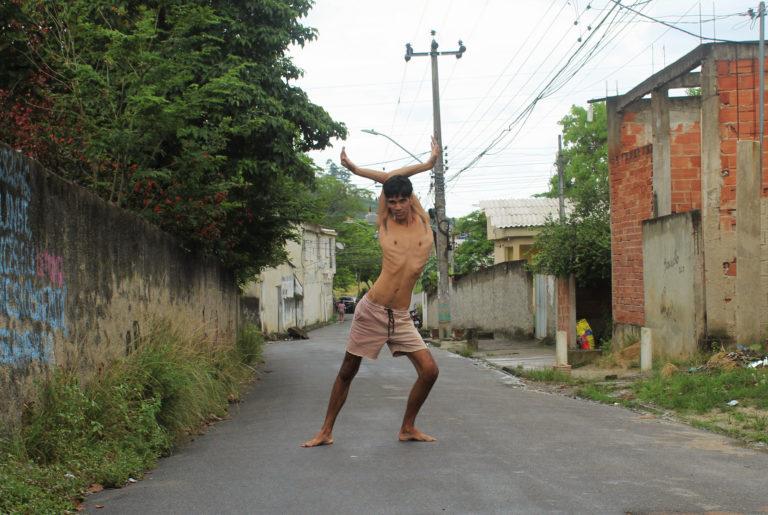
Breno de Sant’ana, 2021.
“vinhadinho”, Fotoperformance, 50 x 70 cm.
Young artist BRENO DE SANT'ANA says: “Throughout my research in visual arts, since 2019 I have been developing works related to performance, photography and collage, relating the environment in which I live and which I observe with affections and affections. that crosses me as a contemporary being. Thus, I present artistic proposals based on my body’s experience with the territory.”
The photoperformance “vinhadinho”, which is now part of the CALMON-STOCK COLLECTION, is one of the works in which SANT’ANA experiments with spaces in which he travels through the city of Rio de Janeiro. Independent curator Mariana Maia says about this work: “BRENO DE SANT’ANA describes his “vineyard” as a large animal, a mammal, which has the ability to escape the ambushes of the oppressive society and detect prejudiced people from afar. In the image we see the “vineyard” in its habitat. The outskirts transform into a kind of wild forest, where we see unfinished houses, weeds… The persona presented by the young performer looks at the camera with a voracious and defiant gaze. A body that wants to be photographed. Twisted, almost mimicking a deer, an animal that is sometimes game, but is also the imposing deer king of the forest, the artist gives new meaning to the pejorative word with a touch of regionalism, “vineyard”. Thus, the prejudiced nickname is diluted, becoming a weapon for affirming an identity...BRENO DE SANT’ANA makes the “vineyard” exist and resist on a suburban street and in the world.”
A decade before BRENO DE SANT’ANA was born, in February 1990, the Italian intellectual Teresa de Lauretis, a specialist in the history of consciousness, gave the legendary lecture “Queer Theory: Lesbian and Gay Sexualities” in the USA. Lauretis then became the first academic to associate the term “queer” with the word “theory”, thus paving the way for countless developments that would boost discussions about our way of being and living in the coming decades. The word “queer”, in English, is the derogatory nickname used to designate homosexual men. It derives from the German “quer”, in turn comes from the Latin “torquere” (to twist), which means “transverse”, “diagonal”, “oblique”. Based on this etymology, the Italian Lorenzo Bernini (philosopher and scholar of queer theory at the University of Verona) postulates that “queer” is nothing but the opposite of “straight”, which in turn means “right”, “straight”. More: Bernini in his book “Queer Apocalipsis” states that “from the moment that heterosexuality is traditionally associated with moral rectitude, (straight) it also gains the meaning of “heterosexual”. In this context, Mariana Maia could not be more precise when using the word “twisted” in the analysis of the surprising photoperformance.
In Grammatology (1967), Derrida had already warned that the history of metaphysics – from Plato to Hegel, from the pre-Socratics to Heidegger – had always attributed the origin of truth in general to logos, that is, that truth had always been the operation of demotion and repression of writing to the detriment of “full speech” (whose?) – or if we prefer a Descartian expression, of “cogito, ergo sum” (I think, therefore I am) in relation to writing. In the work of BRENO DE SANT'ANA what we see is the overcoming of cogito or (patriarchal) speech: the body, action and art of this promising artist show that the world is not simply “straight”, but something “twisted”. …And that its performance forged writing as photography, turned into art and baptized with an adjective as powerful as “queer”, enters our heads as vigorously as (as) theory.